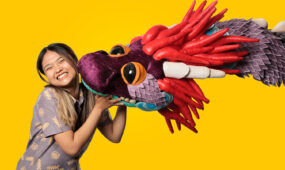Review: Sista Girl
Theatre
Sista Girl sees two women tackling grief, privilege and prejudice as they meet for the first time after the death of their father, a white man who once abandoned one family to be with another.

The first co-production presented by the State Theatre Company of South Australia and Yirra Yaakin Theatre Company in Perth, the play is at times a funny but mostly poignant and sensitive portrayal of how Nakisha and Georgie Grey come to terms with the fact that one sister is Aboriginal and the other is not.

Get InReview in your inbox – free each Saturday. Local arts and culture – covered.
Thanks for signing up to the InReview newsletter.
Sharni McDermott (who stepped into the role of Nakisha after the original actress, Natasha Wanganeen, suffered a family tragedy) and Nadia Rossi do a fine job portraying the painful nature of their situation. They show that family relations are often minefields, no matter how much you love each other.
The sisters resort to shouting but it is the moments in between, the lulls in the storm, that will stay with the audience.
At one point Rossi’s character, Georgie, teaches McDermott’s Nakisha a few words in Italian and the lesson is reciprocated with words in the local Indigenous language. It’s a beautiful scene, echoing the recent Uluru statement that First Nations’ people deserve to be heard.

Nadia Rossi as Georgie. Photo: Kate Pardey
The play – opening in Adelaide during National Reconciliation Week – is a collaboration between writers Elena Carapetis (State Theatre Company resident artist) and Alexis West, who both bring heart and their own experiences to the table.
Now it’s up to the audience to bring theirs and I hope Sista Girl will help to further the discussion between Indigenous and non-Indigenous Australians. It’s one not to be missed.
Sista Girl is playing at the Space Theatre, Adelaide Festival Centre, until June 3, after which it will have a season in Perth in August.
Support local arts journalism
Your support will help us continue the important work of InReview in publishing free professional journalism that celebrates, interrogates and amplifies arts and culture in South Australia.
Donate Here





Comments
Show comments Hide comments